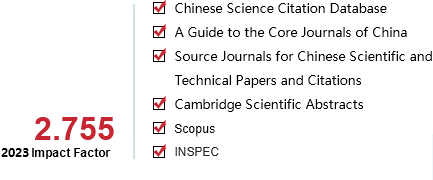[1]MA Long-long,LIU Cheng-lin.On-line handwritten Chinese character recognition using statistical radical models[J].CAAI Transactions on Intelligent Systems,2010,5(5):385-391.[doi:10.3969/j.issn.1673-4785.2010.05.002]
Copy
On-line handwritten Chinese character recognition using statistical radical models
CAAI Transactions on Intelligent Systems[ISSN 1673-4785/CN 23-1538/TP] Volume:
5
Number of periods:
2010 5
Page number:
385-391
Column:
学术论文—机器感知与模式识别
Public date:
2010-10-25
- Title:
- On-line handwritten Chinese character recognition using statistical radical models
- Keywords:
- on-line handwritten Chinese character recognition; statistical radical model; hierarchical structure; over segmentation; path search; radical recognition
- CLC:
- TP391.4
- DOI:
- 10.3969/j.issn.1673-4785.2010.05.002
- Abstract:
- The hierarchical radical structure of Chinese characters can be explored to reduce the number of parameters in character recognition, as well as to improve the generalization ability and adaptability. However, the segmentation of radicals from characters has long been a difficult problem. A new radical-based approach for online handwritten Chinese character recognition was proposed. The approach integrated appearance-based radical recognition and geometric context into a principled framework using a hierarchical character-radical dictionary to guide radical segmentation and recognition during the path search process for the purpose of increasing the accuracy of radical segmentation. The parameters of statistical radical models were estimated in embedded learning. To overcome the connection of strokes between radicals, corner points were detected to extract sub-strokes. For character recognition, two dictionary representation schemes and accordingly different search algorithms were used. The effectiveness of the proposed approach has been demonstrated on Chinese characters of left-right and up-down structures.
- References:
-
[1]LIU Chenglin, JAEGER S, NAKAGAWA M. Online handwritten Chinese character recognition: the state of the art[J]. IEEE Transactions on Pattern Analysis and Machine Intelligence, 2004, 26(2): 198-213.
[2]KWON J, SHIN B, KIM J H. Recognition of on-line cursive Korean characters combining statistical and structural methods[J]. Pattern Recognition, 1997, 30(8): 1255-1263.
[3]KANG K W, KIM J H. Utilization of hierarchical stochastic relationship modeling for Hangul character recognition[J]. IEEE Transactions on Pattern Analysis and Machine Intelligence, 2004, 26(9): 1185-1196.
[4]OTA I, YAMAMOTO R, NISHIMOTO T, et al. Online handwritten kanji recognition based on inter-stroke grammar[C]//Proceedings of the 9th International Conference on Document Analysis and Recognition. Curitiba, Brazil, 2007: 1188-1192.
[5]KAWAMURA A, YURA K, HAYAMA T, et al. On-line recognition of freely handwritten Japanese characters using directional feature densities[C]//Proceedings of the 11th International Conference on Pattern Recognition. Hague, Netherlands, 1992, 2: 183-186.
[6]HAMANAKA M, YAMADA K, TSUKUMO J. On-line Japanese character recognition experiments by an off-line method based on normalized-cooperated feature extraction[C]//Proceedings of the 2nd International Conference on Document Analysis and Recognition. Tsukuba, Japan, 1993: 204-207.
[7]KIM H J, KIM K H, KIM S K, et al. On-line recognition of handwritten Chinese characters based on hidden Markov models[J]. Pattern Recognition, 1997, 30(9): 1489-1499.
[8]NAKAI M, AKIRA N, SHIMODAIRA H, et al. Substroke approach to HMM-based on-line kanji handwriting recognition[C]//Proceedings of the 6th International Conference on Document Analysis and Recognition. Seattle, USA, 2001: 491-495.
[9]ZHANG Yaodong, LIU Peng, SOONG F K. Minimum error discriminative training for radical-based online Chinese handwriting recognition[C]//Proceedings of the 9th International Conference on Document Analysis and Recognition. Curitiba, Brazil, 2007: 53-57.
[10]LIU Yingjian, ZHANG Liqin, DAI Juwei. A new approach to on-line handwriting Chinese character recognition[C]//Proceedings of the 2nd International Conference on Document Analysis and Recognition. Tsukuba, Japan, 1993: 192-195.
[11]CHELLAPILLA K, SIMARD P. A new radical based approach to offline handwritten East-Asian character recognition[C]//Proceedings of the 10th International Workshop on Frontiers in Handwriting Recognition. La Baule, France, 2006: 261-266.
[12]LIU Chenglin, KOGA M, FUJISAWA H. Lexicon-driven segmentation and recognition of handwritten character strings for Japanese address reading[J]. IEEE Transactions on Pattern Analysis and Machine Intelligence, 2002, 24(11): 1425-1437.
[13]MA Longlong, LIU Chenglin. A new radical-based approach to online handwritten Chinese character recognition[C]//Proceedings of the 19th International Conference on Pattern Recognition. Tampa, USA, 2008: 1-4.
[14]MA Longlong, LIU Chenglin. On-line handwritten Chinese character recognition based on nested segmentation of radicals[C]//Proceedings of 2009 Chinese Conference on Pattern Recogniton & First CJK Joint Workshop on Pattern Recognition. Nanjing, China, 2009: 1-5.
[15]LIU Chenglin, ZHOU Xiangdong. Online Japanese character recognition using trajectory-based normalization and direction feature extraction[C]//Proceedings of the 10th International Workshop on Frontiers in Handwriting Recognition. La Baule, France, 2006: 217-222.
[16]KIMURA F, TAKASHINA K, TSURUOKA S, et al. Modified quadratic discriminant functions and the application to Chinese character recognition[J]. IEEE Transactions on Pattern Analysis and Machine Intelligence, 1987, 9(1): 149-153.
- Similar References:
Memo
-
Last Update:
2010-11-24
